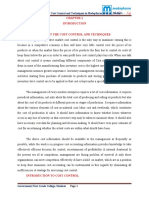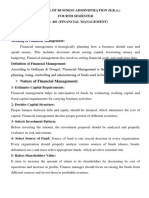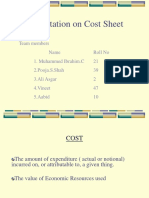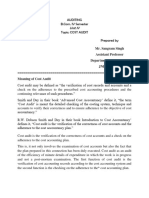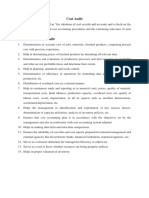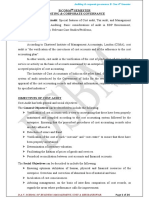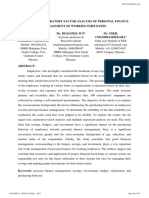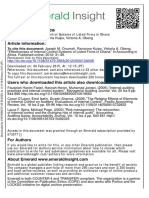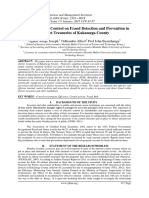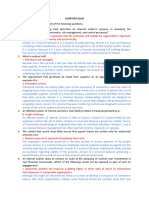100% found this document useful (1 vote)
2K views11 pagesModule 5 SCM Mba
The document outlines the Strategic Cost Management course for MBA Finance, focusing on cost audit, management audit, and reporting to management. It details the objectives, advantages, and types of cost audits and reports, emphasizing their importance in decision-making, compliance, and efficiency improvement. Additionally, it covers segment reporting, its purpose, criteria, and benefits, highlighting its role in enhancing transparency and performance analysis within organizations.
Uploaded by
Dr UMA KCopyright
© © All Rights Reserved
We take content rights seriously. If you suspect this is your content, claim it here.
Available Formats
Download as DOCX, PDF, TXT or read online on Scribd
100% found this document useful (1 vote)
2K views11 pagesModule 5 SCM Mba
The document outlines the Strategic Cost Management course for MBA Finance, focusing on cost audit, management audit, and reporting to management. It details the objectives, advantages, and types of cost audits and reports, emphasizing their importance in decision-making, compliance, and efficiency improvement. Additionally, it covers segment reporting, its purpose, criteria, and benefits, highlighting its role in enhancing transparency and performance analysis within organizations.
Uploaded by
Dr UMA KCopyright
© © All Rights Reserved
We take content rights seriously. If you suspect this is your content, claim it here.
Available Formats
Download as DOCX, PDF, TXT or read online on Scribd
/ 11
3rd Semester MBA Finance Electives
Strategic Cost Management Course Code 22MBAFM303
Module-5 Cost Audit& Reporting to Management-objectives and advantages of Cost
Audit, Cost Audit report. Management Audit- Objectives and Scope. Reporting to
Management – Purpose of reporting Requisites of a good report, Classifications of Report,
Segment reporting, Cost Reduction and Cost Control, Target Costing – its Principles,
Balanced Scorecard: Features and Purpose (theory only).
Dr. UMA K
Assistant Professor
Module-5
5.1. Cost Audit& Reporting to Management-objectives and advantages of Cost Audit
1. Meaning of Cost Audit: Cost Audit is the systematic examination of cost records to
verify their accuracy and ensure compliance with cost accounting principles. 📌 It helps in
controlling costs, improving efficiency, and ensuring fair pricing of products/services.
2. Objectives of Cost Audit
✔ 1. Verification of Cost Records – Ensures cost records are maintained as per cost
accounting standards.
✔ 2. Detection of Errors & Frauds – Identifies misstatements, frauds, and manipulation in
cost accounts.
✔ 3. Cost Control & Cost Reduction – Helps in analysing cost structures to improve
efficiency and reduce waste.
✔ 4. Efficiency Improvement – Evaluates production efficiency and suggests
improvements.
✔ 5. Standardization of Costing Methods – Ensures uniformity in cost accounting
procedures.
✔ 6. Fair Pricing Policy – Helps in setting fair and reasonable prices for goods and services.
✔ 7. Compliance with Regulations – Ensures adherence to statutory requirements under the
Companies Act and Cost Accounting Rules.
✔ 8. Decision-Making Support – Provides accurate cost data for better business decisions.
✔ 9. Prevention of Misuse of Resources – Identifies areas of cost leakage and
inefficiencies.
✔ 10. Investor & Stakeholder Confidence – Increases transparency and builds trust among
investors and regulators.
3. Advantages of Cost Audit
A. Advantages to the Management
✅ 1. Identifies Cost Inefficiencies – Helps management take corrective actions to reduce
costs.
✅ 2. Improves Profitability – Ensures better cost control, leading to increased profits.
✅ 3. Helps in Decision-Making – Provides accurate cost data for strategic decisions.
✅ 4. Better Resource Utilization – Prevents wastage and misuse of resources.
✅ 5. Evaluates Performance – Compares actual costs with standards for performance
analysis.
B. Advantages to the Government
✅ 6. Ensures Compliance – Helps in ensuring companies follow cost-related legal
requirements.
✅ 7. Prevents Tax Evasion – Reduces chances of financial misreporting and fraud.
✅ 8. Fair Pricing Policy – Assists the government in regulating prices of essential goods.
C. Advantages to Shareholders & Investors
✅ 9. Increases Transparency – Builds confidence in financial reports and cost data.
✅ 10. Protects Investors’ Interests – Ensures fair returns by controlling costs and improving
efficiency.
D. Advantages to the Economy
✅ 11. Promotes Industrial Growth – Encourages better cost management, leading to
business growth.
✅ 12. Reduces Inflationary Pressures – Helps in keeping product prices stable by
controlling costs.
Conclusion:
📌 Cost Audit is essential for cost control, efficiency improvement, and regulatory
compliance.
📌 It benefits businesses, the government, and the overall economy by ensuring transparency
and accountability in cost management.
5.2. Cost Audit report
1. Meaning of Cost Audit Report: A Cost Audit Report is a document prepared by a cost
auditor that presents findings on the company’s cost records, cost efficiency, and compliance
with cost accounting standards.
📌 It is submitted to management and regulatory authorities for decision-making and ensuring
transparency.
2. Contents of a Cost Audit Report
✔ 1. Introduction – Brief details of the company, industry, and audit scope.
✔ 2. Cost Accounting Policies – Methods used for cost allocation, valuation, and
classification.
✔ 3. Examination of Cost Records – Verification of compliance with cost accounting
standards and laws.
✔ 4. Cost Variance Analysis – Differences between standard and actual costs with reasons.
✔ 5. Production and Efficiency Analysis – Review of production efficiency, wastages, and
cost-saving measures.
✔ 6. Capacity Utilization – Analysis of the company’s ability to use its production capacity
effectively.
✔ 7. Overhead Cost Allocation – Study of how overhead costs (fixed and variable) are
distributed.
✔ 8. Profitability Analysis – Assessment of cost-effectiveness and overall profitability.
✔ 9. Recommendations – Suggestions for cost reduction, efficiency improvement, and
compliance.
✔ 10. Auditor’s Conclusion – Final remarks on cost records' accuracy, compliance, and
areas for improvement.
3. Types of Cost Audit Reports
✔ 1. Statutory Cost Audit Report – Prepared as per legal requirements under the
Companies Act.
✔ 2. Internal Cost Audit Report – Submitted to company management for internal
decision-making.
✔ 3. Cost Efficiency Report – Focuses on cost control and productivity improvement.
✔ 4. Cost Compliance Report – Ensures adherence to cost accounting standards and
regulations.
4. Submission & Compliance
✅ 1. Submission to Regulatory Authorities – As per the Companies Act, a cost audit report
must be submitted to the government if required.
✅ 2. Timely Reporting – Must be prepared and submitted within the prescribed time limit.
✅ 3. Compliance with Cost Accounting Standards – The report should follow prescribed
cost accounting rules and principles.
5. Importance of Cost Audit Report
✔ 1. Helps in Cost Control – Identifies areas where costs can be reduced.
✔ 2. Ensures Compliance – Confirms adherence to cost accounting standards.
✔ 3. Improves Decision-Making – Provides data for management to optimize costs.
✔ 4. Enhances Profitability – Suggests ways to improve cost efficiency and profitability.
✔ 5. Increases Transparency – Assures stakeholders of fair cost practices.
✅ Conclusion:
📌 The Cost Audit Report plays a crucial role in cost management, regulatory compliance,
and improving operational efficiency.
📌 It helps businesses reduce costs, improve decision-making, and ensure transparency in
financial operations.
5.3. Management Audit-
1. Meaning of Management Audit
📌 Management Audit is a systematic examination of the effectiveness, efficiency, and
performance of the management of an organization.
📌 It evaluates policies, procedures, and decision-making processes to improve overall
corporate governance.
2. Objectives of Management Audit
✔ 1. Evaluating Management Efficiency – Assesses how well management utilizes
resources.
✔ 2. Improving Decision-Making – Identifies weaknesses in management’s decision-
making process.
✔ 3. Ensuring Goal Achievement – Checks if organizational objectives are being met
effectively.
✔ 4. Enhancing Productivity – Identifies inefficiencies and suggests ways to improve
productivity.
✔ 5. Cost Control & Reduction – Helps in minimizing costs and avoiding unnecessary
expenditures.
✔ 6. Performance Analysis – Examines key performance indicators (KPIs) of different
departments.
✔ 7. Identifying Weaknesses – Detects flaws in policies, procedures, and implementation.
✔ 8. Compliance with Policies – Ensures adherence to company policies, laws, and ethical
practices.
✔ 9. Strengthening Internal Controls – Suggests improvements in internal control
mechanisms.
✔ 10. Risk Management – Identifies potential risks and suggests mitigation strategies.
✔ 11. Enhancing Employee Morale – Reviews HR policies and their impact on employee
motivation.
✔ 12. Improving Customer Satisfaction – Evaluates marketing and customer service
effectiveness.
3. Scope of Management Audit
📌 The scope of a management audit covers different functional areas of the organization:
A. General Management
✅ 1. Organizational Structure – Effectiveness of hierarchy and reporting system.
✅ 2. Leadership Effectiveness – Assessment of management leadership and decision-
making.
✅ 3. Corporate Policies – Evaluation of company policies and their implementation.
B. Financial Management
✅ 4. Budgeting & Cost Control – Effectiveness of financial planning and cost management.
✅ 5. Investment & Capital Management – Review of investment decisions and capital
allocation.
✅ 6. Profitability Analysis – Evaluation of profit margins and revenue sources.
C. Human Resource Management
✅ 7. Recruitment & Training – Efficiency of hiring, training, and employee development.
✅ 8. Performance Appraisal – Effectiveness of performance evaluation and promotions.
✅ 9. Employee Satisfaction – Review of HR policies and workplace culture.
D. Operations & Production
✅ 10. Production Efficiency – Analysis of operational effectiveness and productivity.
✅ 11. Quality Control – Review of product/service quality standards.
✅ 12. Supply Chain & Inventory Management – Efficiency of procurement and stock
management.
E. Marketing & Sales
✅ 13. Market Positioning – Evaluation of market strategies and branding.
✅ 14. Sales Performance – Analysis of sales growth and customer satisfaction.
✅ 15. Advertising & Promotion – Effectiveness of marketing campaigns.
F. IT & Technology
✅ 16. Digital Transformation – Use of technology for business efficiency.
✅ 17. Data Security & IT Policies – Review of cybersecurity and data management.
G. Legal & Compliance
✅ 18. Regulatory Compliance – Ensuring adherence to legal and industry regulations.
✅ 19. Ethical Practices – Evaluation of corporate social responsibility and ethical standards.
Conclusion:
📌 Management Audit is a powerful tool for assessing and improving business efficiency.
📌 It covers all key functional areas, ensures cost-effectiveness, enhances decision-making,
and helps in achieving business goals.
5.4. Reporting to Management
1. Meaning of Reporting to Management
📌 Reporting to management refers to the systematic communication of relevant business
information to assist managers in decision-making.
📌 Reports provide insights into financial performance, operational efficiency, and strategic
progress.
2. Purpose of Reporting to Management
✔ 1. Aids in Decision-Making – Provides essential data for informed decision-making.
✔ 2. Performance Evaluation – Assesses efficiency and effectiveness of various
departments.
✔ 3. Cost Control & Reduction – Helps in identifying cost-saving opportunities.
✔ 4. Compliance & Regulation – Ensures adherence to legal and company policies.
✔ 5. Identifies Strengths & Weaknesses – Highlights areas of improvement and success.
✔ 6. Facilitates Coordination – Ensures smooth communication among different business
units.
✔ 7. Risk Management – Identifies and mitigates potential business risks.
✔ 8. Improves Accountability – Encourages transparency and responsibility at all levels.
✔ 9. Enhances Strategic Planning – Assists in long-term planning and goal setting.
✔ 10. Supports Budgeting & Forecasting – Provides financial projections and budget
analysis.
3. Requisites of a Good Report
A. Content & Structure
✅ 1. Clarity & Conciseness – Should be clear, concise, and to the point.
✅ 2. Accuracy & Reliability – Must contain correct and verified information.
✅ 3. Relevance – Should focus only on necessary and meaningful information.
✅ 4. Completeness – Must cover all key aspects without missing critical details.
✅ 5. Logical Organization – Information should be presented in a structured manner.
B. Presentation & Format
✅ 6. Use of Visuals – Charts, graphs, and tables enhance understanding.
✅ 7. Simple & Understandable Language – Avoids jargon and complex terminology.
✅ 8. Proper Categorization – Divides sections for easy readability.
C. Timeliness & Accessibility
✅ 9. Timely Submission – Should be provided at the right time for decision-making.
✅ 10. Easy Accessibility – Should be easily available to relevant stakeholders.
D. Objectivity & Impartiality
✅ 11. Free from Bias – Should present facts without personal opinions.
✅ 12. Action-Oriented – Must include recommendations for improvement.
✅ Conclusion:
📌 Management reporting is essential for effective decision-making and business success.
📌 A good report should be clear, accurate, relevant, timely, and action-driven to serve its
purpose efficiently.
5.6. Segment reporting
1. Meaning and Definition of Segment Reporting
Segment Reporting refers to the practice of disclosing financial information for
different business segments within an organization.
It helps stakeholders understand how various parts of a company contribute to its
overall financial performance.
Definition: According to the International Financial Reporting Standards (IFRS 8)
and Generally Accepted Accounting Principles (GAAP), segment reporting requires
companies to report financial results separately for different segments based on
their operations, geography, or other criteria.
2. Purpose of Segment Reporting
Better Decision-Making: Helps investors and management analyze the performance
of individual segments.
Transparency: Enhances accountability by showing how different business units
perform.
Risk Assessment: Identifies profitable and underperforming segments to manage
risks effectively.
Comparability: Enables comparisons of financial performance across different
industries and competitors.
3. Criteria for Identifying Segments
3.1 Operating Segments
A business segment is identified if it meets at least one of the following conditions:
Revenue Test: Generates at least 10% of the company's total revenue.
Profit/Loss Test: Contributes at least 10% of the company's total profit or loss.
Asset Test: Owns at least 10% of the company’s total assets.
If total reportable segments account for less than 75% of total external revenue,
additional segments must be reported.
3.2 Types of Segments
Business Segments: Based on different product lines or services.
o Example: Apple Inc. reports segments like iPhone, Mac, iPad, and Services.
Geographical Segments: Based on different regions or countries.
o Example: McDonald's reports financials separately for North America,
Europe, Asia-Pacific, and Other Regions.
4. Key Components of Segment Reporting
Companies must disclose the following for each segment:
Revenue: Both from external customers and inter-segment sales.
Expenses: Directly related to the segment’s operations.
Profit/Loss: Segment’s contribution to overall company performance.
Assets & Liabilities: Resources allocated to each segment.
Other Information: Capital expenditures, depreciation, and non-cash expenses.
5. Example of Segment Reporting
Example 1: Amazon Inc.
Amazon reports its financial performance under three segments:
1. North America: Includes all sales in the U.S. and Canada.
2. International: Includes revenue from Europe, Asia, and other regions.
3. Amazon Web Services (AWS): Cloud computing and digital services.
Sample Segment Reporting Data (Hypothetical)
Segment Revenue ($ Billion) Profit ($ Billion) Assets ($ Billion)
North America 200 15 100
International 120 8 80
AWS 90 30 50
Example 2: Tata Motors: Tata Motors reports its financials under three business segments:
1. Passenger Vehicles (Tata Nexon, Tata Harrier)
2. Commercial Vehicles (Tata Trucks, Buses)
3. Jaguar Land Rover (JLR) (Luxury car segment)
Each segment’s revenue and profit are separately reported to provide insights into their
performance.
6. Benefits of Segment Reporting
Improved Performance Analysis: Helps businesses assess which segments are
profitable.
Investor Confidence: Increases transparency for investors and stakeholders.
Efficient Resource Allocation: Management can allocate resources effectively to
high-performing segments.
Compliance with Regulations: Meets regulatory requirements of IFRS and GAAP.
7. Challenges in Segment Reporting
Data Complexity: Requires accurate allocation of revenue, expenses, and assets
across segments.
Confidentiality Issues: Companies may hesitate to disclose sensitive financial
details.
Consistency in Reporting: Different accounting policies can create inconsistencies.
Conclusion
Segment reporting provides valuable insights into business performance, helping
investors, regulators, and management make informed decisions.
Companies like Amazon, Apple, and Tata Motors use segment reporting to disclose
financial details of their different business units.
Despite challenges, it remains an essential part of financial disclosure for
multinational and diversified companies.
5.5. Classifications of Report
1. Meaning of Management Reports
📌 Management reports are structured documents that provide critical business insights to
help managers make informed decisions.
📌 They analyse financial, operational, and strategic aspects of a business.
2. Classification of Management Reports
Management reports can be classified based on various factors such as purpose, frequency,
function, and nature.
A. Based on Purpose
✅ 1. Operational Reports – Focus on daily business activities, e.g., production reports, sales
reports.
✅ 2. Financial Reports – Provide financial insights like profit/loss statements, balance
sheets, and cash flow reports.
✅ 3. Strategic Reports – Used for long-term planning and decision-making, e.g., market
analysis, business expansion reports.
✅ 4. Compliance Reports – Ensure adherence to legal and regulatory requirements, e.g., tax
audit reports.
B. Based on Frequency
✅ 5. Routine Reports – Prepared periodically (daily, weekly, monthly) for regular
monitoring, e.g., daily sales reports.
✅ 6. Special Reports – Prepared for specific situations like crisis management,
investigations, or ad hoc decision-making.
✅ 7. Annual Reports – Comprehensive reports covering yearly business performance,
typically for stakeholders.
C. Based on Function
✅ 8. Sales & Marketing Reports – Analyze market trends, customer behavior, and sales
performance.
✅ 9. Production Reports – Track manufacturing efficiency, inventory levels, and supply
chain performance.
✅ 10. HR & Employee Reports – Assess workforce performance, employee engagement,
and HR policies.
✅ 11. IT & Technology Reports – Review cybersecurity, IT infrastructure, and system
efficiency.
D. Based on Nature
✅ 12. Qualitative Reports – Focus on non-numeric insights, like employee feedback or
customer satisfaction surveys.
✅ 13. Quantitative Reports – Contain statistical and numerical data, like financial
statements.
✅ Conclusion:
📌 Management reports are classified based on their purpose, frequency, function, and nature.
📌 These reports play a crucial role in decision-making, monitoring performance, and
ensuring business efficiency.
Cost Reduction and Cost Control
1. Meaning of Cost Reduction & Cost Control
📌 Cost Reduction refers to the continuous efforts to minimize costs without compromising
quality, efficiency, or productivity. It focuses on permanent savings in production, operation,
or administration.
📌 Cost Control involves monitoring and regulating costs within pre-determined budgets to
ensure expenses do not exceed planned levels. It focuses on keeping costs within set limits.
2. Difference Between Cost Reduction and Cost Control
Aspect Cost Reduction Cost Control
Focus Permanent reduction in costs Keeping costs within set limits
Scope Long-term strategy Short-term monitoring
Improve efficiency, eliminate
Objective Maintain budget discipline
waste
Process improvement,
Method Budgeting, variance analysis
innovation
Impact on Ensures cost adherence without affecting
No compromise on quality
Quality quality
3. Objectives of Cost Reduction
✔ 1. Increase Profitability – Reduces expenses to improve margins.
✔ 2. Improve Efficiency – Enhances operational effectiveness.
✔ 3. Eliminate Waste – Removes unnecessary expenditures.
✔ 4. Enhance Competitiveness – Helps in offering competitive pricing.
✔ 5. Optimize Resource Utilization – Ensures better use of materials, labor, and machinery.
4. Objectives of Cost Control
✔ 1. Ensure Budget Adherence – Prevents overspending.
✔ 2. Monitor & Reduce Unnecessary Expenses – Keeps costs aligned with expected
targets.
✔ 3. Improve Decision-Making – Helps management in financial planning.
✔ 4. Enhance Accountability – Encourages responsible spending.
✔ 5. Maintain Profit Margins – Keeps expenses in check without reducing revenues.
5. Techniques of Cost Reduction
✅ 1. Process Improvement – Using lean manufacturing and automation.
✅ 2. Value Engineering – Redesigning processes to reduce costs.
✅ 3. Standardization – Reducing product variety to lower production costs.
✅ 4. Waste Reduction – Minimizing defective production and inefficiencies.
✅ 5. Outsourcing – Subcontracting non-core activities to save costs.
✅ 6. Energy Conservation – Reducing electricity, water, and fuel expenses.
6. Techniques of Cost Control
✅ 1. Budgetary Control – Setting cost limits and monitoring performance.
✅ 2. Standard Costing – Comparing actual costs with standard costs.
✅ 3. Variance Analysis – Identifying and analyzing cost deviations.
✅ 4. Inventory Control – Reducing excess stock and wastage.
✅ 5. Performance Measurement – Monitoring efficiency through KPIs.
7. Benefits of Cost Reduction & Cost Control
✔ 1. Higher Profitability – Direct impact on net profits.
✔ 2. Competitive Pricing – Helps in offering lower prices in the market.
✔ 3. Improved Financial Stability – Reduces financial stress.
✔ 4. Better Resource Utilization – Ensures optimal use of materials, labor, and machinery.
✔ 5. Sustainable Business Growth – Supports long-term financial health.
✅ Conclusion:
📌 Cost Reduction and Cost Control are essential strategies for improving business
profitability and efficiency.
📌 While cost control prevents unnecessary expenses within budgets, cost reduction focuses
on continuous improvements and innovation to lower costs permanently.
5.8. Target Costing – its principles
Target Costing – Principles & Key Points
1. Meaning of Target Costing
📌 Target costing is a cost management technique where a company determines the
maximum allowable cost of a product based on the expected selling price and desired profit
margin.
📌 It is a proactive cost control method used during the product design and development stage
to ensure profitability.
2. Principles of Target Costing
✔ 1. Market-Driven Pricing – The selling price is determined based on market conditions,
competition, and customer expectations.
✔ 2. Profit Planning – The company sets a target profit margin and works backward to
determine the allowable cost.
✔ 3. Cost Reduction Focus – Emphasizes cost control from the product design stage rather
than after production.
✔ 4. Cross-Functional Team Approach – Involves departments like design, engineering,
marketing, and finance in cost planning.
✔ 5. Customer-Oriented Design – Ensures the product meets customer needs while staying
within cost limits.
✔ 6. Continuous Improvement – Encourages ongoing cost reduction through innovation,
process efficiency, and supplier collaboration.
✔ 7. Value Engineering – Analyzes alternative materials, processes, and designs to maintain
quality at lower costs.
✔ 8. Supplier Involvement – Engages suppliers early in the process to achieve cost
efficiencies in raw materials and components.
✔ 9. Life Cycle Costing – Considers costs over the entire product life cycle, including
production, maintenance, and disposal.
✔ 10. Competitive Advantage – Helps businesses maintain profitability while offering
competitive prices.
3. Formula for Target Costing
📌 Target Cost = Target Selling Price – Target Profit
📌 Example:
Target Selling Price = $100
Target Profit = $20
Target Cost = $100 - $20 = $80 (The company must produce the product within $80
to remain profitable).
4. Benefits of Target Costing
✔ 1. Helps in Cost Control from the Beginning – Prevents excessive production costs.
✔ 2. Ensures Competitive Pricing – Enables businesses to price their products attractively.
✔ 3. Enhances Profitability – Maintains profit margins through efficient cost management.
✔ 4. Promotes Innovation – Encourages design improvements to reduce costs.
✔ 5. Improves Supplier Collaboration – Works closely with suppliers for cost-effective
sourcing.
✔ 6. Reduces Waste & Inefficiencies – Eliminates unnecessary costs in production.
✅ Conclusion:
📌 Target costing is a strategic cost management approach that aligns product design, pricing,
and cost control to maintain profitability.
📌 It ensures that businesses remain competitive while meeting customer needs at the lowest
possible cost.
5.9. Balanced Scorecard: Features and Purpose (theory only).
1. Meaning of Balanced Scorecard (BSC)
📌 The Balanced Scorecard (BSC) is a strategic performance management tool used to track
and measure an organization's performance beyond just financial metrics.
📌 It includes four key perspectives: Financial, Customer, Internal Processes, and
Learning & Growth to ensure a balanced approach to business success.
2. Features of Balanced Scorecard
✔ 1. Multi-Dimensional Approach – Measures financial and non-financial performance.
✔ 2. Four Key Perspectives – Includes Financial, Customer, Internal Business Processes,
and Learning & Growth.
✔ 3. Aligns with Strategy – Links performance measurement with the organization’s
strategic objectives.
✔ 4. Focuses on Long-Term Goals – Encourages sustainable growth and development.
✔ 5. Performance Measurement Tool – Helps in evaluating success across different
business areas.
✔ 6. Integrates Business Functions – Ensures coordination between different departments.
✔ 7. Decision-Making Support – Provides insights for better strategic decisions.
✔ 8. Continuous Improvement – Encourages businesses to improve processes and
outcomes.
✔ 9. Customer-Centric Approach – Measures customer satisfaction and market
positioning.
✔ 10. Helps in Risk Management – Identifies potential risks and mitigates them through
strategic actions.
3. Purpose of Balanced Scorecard
✔ 1. Improve Organizational Performance – Provides a structured framework for
evaluating success.
✔ 2. Enhance Strategic Alignment – Ensures that all departments work towards common
goals.
✔ 3. Monitor Financial Health – Tracks revenue, cost efficiency, and profitability.
✔ 4. Strengthen Customer Focus – Evaluates customer satisfaction and loyalty.
✔ 5. Optimize Internal Processes – Identifies areas for efficiency improvement.
✔ 6. Encourage Innovation & Learning – Promotes employee training and skill
development.
✔ 7. Provide Holistic Business Insights – Offers a 360-degree view of organizational
performance.
✔ 8. Foster Accountability – Assigns responsibility for achieving specific targets.
✔ 9. Facilitate Better Decision-Making – Helps managers make informed, data-driven
decisions.
✔ 10. Achieve Competitive Advantage – Ensures the organization stays ahead in the
market.
✅ Conclusion:
📌 The Balanced Scorecard is a comprehensive performance management tool that ensures
organizations measure success beyond financial figures.
📌 by integrating financial, customer, internal processes, and learning & growth
perspectives, BSC helps businesses achieve long-term strategic objectives.










